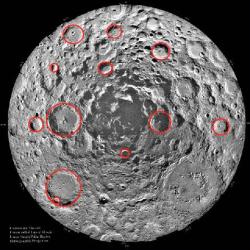Source Institutions
Source Institutions
Add to list Go to activity
Activity link broken? See if it's at the internet archive

In this activity (page 7 of PDF), learners will identify the general two-dimensional geometric shape of the uppermost cross section of an impact crater. They will also draw connections between the general two-dimensional geometric shape of an impact crater and the projectile's angle of impact. There are two versions of this activity: Challenge, where students construct a launcher and create their own craters; and Non-Challenge where students analyze pictures of craters. The Moon Math: Craters! guide follows a 5E approach, applying concepts of geometry, modeling, data analysis to the NASA lunar spacecraft mission, LCROSS.
- 10 to 30 minutes
- 45 to 60 minutes
- $10 - $20 per student
- Ages 8 - 14
- Activity, Lesson/Lesson Plan, Simulation
- English
Quick Guide
Materials List (per student)
- Shallow pan (aluminum baking pan, cardboard box lid, dishpan, etc.)
- Soil-like substance (dirt, sand, flour, fine kitty litter, etc.)
- Spherical projectile
- Launching device
- Bed sheet (or other drape for spreading on the floor under the pan of soil)
- Activity A – Shapes and Angles student worksheet (p. 53 of PDF)
- Shocking Shapes article (p. 44 of PDF)
- Non-Challenge Version -- Activity A – Impact Crater Images (p. 52 of PDF)
Subjects
-
Earth and Space Science
-
Astronomy
- Probes, Satellites and Spacecraft
-
Solar System
- The Moon
- Asteroids and Comets
-
Astronomy
-
Mathematics
-
Geometry
- Plane Geometry
-
Measurement
- Size and Scale
- Circles
-
Geometry
-
Physical Sciences
-
Motion and Forces
- Momentum and Velocity
- Projectile Motion
-
Motion and Forces
-
The Nature of Science
-
The Scientific Process
- Conducting Investigations
- Gathering Data
-
The Scientific Process
Audience
To use this activity, learners need to:
- see
- read
- be mobile
- touch
Learning styles supported:
- Involves hands-on or lab activities
Other
Components that are part of this resource:
Includes alignment to state and/or national standards:
This resource is part of:
Access Rights:
- Free access
By:
- NASA
Rights:
- Public domain, ,
